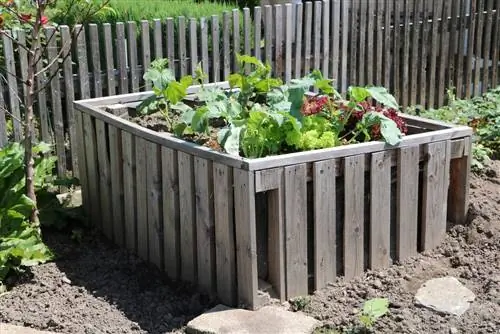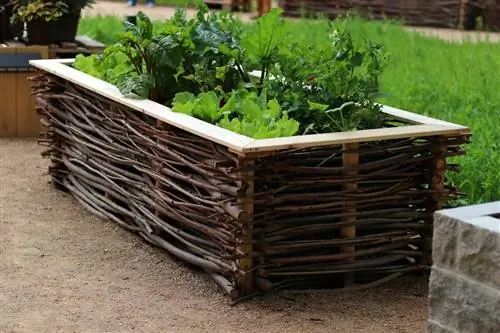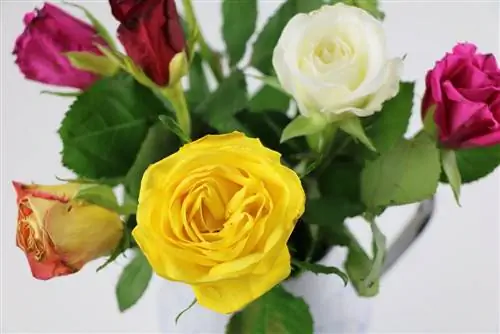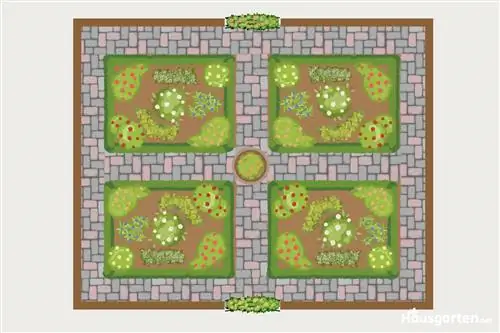- Author admin [email protected].
- Public 2023-12-17 03:39.
- Last modified 2025-06-01 06:48.
Once hobby gardeners have fulfilled their dream of having their own raised bed in the garden, the development of the planting plan is on the agenda. Does gardening at table height ensure the highest possible harvest yield of crunchy vegetables and aromatic herbs? Or have you given the raised bed an ornamental character with magnificent floral decorations? How good that clear rules and regulations show the way to skillfully planting a raised bed. Familiarize yourself with the best plants for the 1st year here.
Planting raised beds
After the frame of the raised bed is completed, it's time to fill it correctly before you can put your planting plan into action. The preparations should be completed by mid-May because then the window of opportunity for planting opens. The substrate in the raised bed is made up of these layers:
- To protect against pests, line the floor with a close-meshed wire mesh
- Each additional layer is 25 to 27 centimeters thick
- First layer: drainage made of pottery shards, grit and gravel - thinly covered with soil
- Second layer: branches, twigs and clippings from bushes - thinly covered with soil
- Third layer: Half-rotted plant residues, such as stems, leaves and coarse compost
- Fourth layer: Mixture of humus garden soil, potting soil and 2-3 year old compost
If cavities form during the layering process, they are stuffed with compost, leaves or paper. The second layer is ideally enriched with a little calcium cyanamide (approx.100 grams per square meter). If you have it on hand, add some rock dust to the top layer. It is a great advantage for planting and care work as well as for the productivity of a raised bed if the soil rises slightly towards the middle in the form of a small hill.
Planting season starts in May
It is recommended to create and fill a raised bed in the fall. At this time of year the garden provides an abundance of suitable material for planting. The soil can settle until the main planting season begins in May so that the upper layer can be replenished if necessary. Of course, this doesn't mean that you leave your new raised bed unused throughout the winter. If you plant heather, asters and chrysanthemums in September and October, the eye will be delighted by the first splendor of flowers. If you put flower bulbs in the ground, such as tulips, daffodils and crocuses, the time until May will be wonderfully bridged. How to plant the raised bed with expertise:
- Soak the young plants you have purchased or grown yourself in water
- In the meantime, rake the soil thoroughly and remove weeds
- Dig small holes at appropriate distances according to the planting plan
- A suitable planting hole has 1.5 to 2 times the volume of the root ball
- Unpot the young plants, place them in the planting holes, press down the soil and water
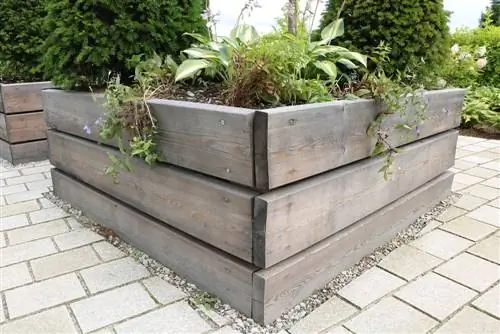
One of the outstanding advantages of a raised bed is that you can set the planting distance closer than in an open-air bed. Cauliflower, for example, is not planted at a distance of 50 x 50 cm, but thrives best at a distance of 30 x 30 cm. Celeriac is sufficient with 20-25 cm and celery stalks with 10-15 cm.
The best vegetable plants to start with
In a raised bed, the plants encounter a concentrated load of nutrients. Significantly higher temperatures develop within the heaped earth than in the open field. The process forces decomposition, resulting in a high concentration of nutrients. This circumstance largely defines which types of vegetables should be planted in the first year. All heavy eaters are eligible, as they consume a lot of nutrients without accumulating nitrates. The following palette provides an overview:
- Aubergines
- Beans: both bush and pole beans
- Types of cabbage: from cauliflower to white cabbage
- Cucumbers
- Potatoes: early and late varieties as well as sweet potatoes
- Peppers
- Celery
- Spinach
- Beetroot
- Tomatoes
Vegetables that require a lot of space are not recommended for growing in raised beds, even if they are heavy feeders. Spacious zucchini, mighty pumpkins or huge rhubarb cope better with a ground-level bed location.
Tip:
Covered with fleece, a thermal hood or leaves, the raised bed produces a vitamin-rich harvest of Brussels sprouts, kale, leeks and savoy cabbage well into winter.
Thoughtful mixed culture

The mixed culture cultivation concept can easily be transferred to raised beds. In order to benefit from the numerous advantages of a colorfully mixed plant culture from the first year onwards, it is not enough to just pay attention to the intensity of nutrient consumption. In addition, it should be taken into account to what extent the vegetable plants in the immediate vicinity get along. The following combinations may serve as a suggestion:
Good neighborhoods for the first planting plan in the raised bed
- Cucumbers: cauliflower, Chinese cabbage, Brussels sprouts,
- Potatoes: beans, cucumbers, leeks, peppers, celery, spinach, tomatoes
- Brussels sprouts: celery, leek
- Celery: beans, cucumbers, Brussels sprouts, Chinese cabbage, winter leeks, tomatoes
- Spinach: beans, potatoes early and late, all types of cabbage, tomatoes
- Beetroot: bush beans, runner beans, onions
- Tomatoes: beans, cauliflower, winter leeks, spinach, celery
Avoid planting cucumbers next to potatoes and tomatoes. Likewise, potatoes don't get along well with celery and beetroot. In addition, leeks do not like to be placed next to beetroot and beans. Red cabbage and tomatoes may make a decorative color combination, but both vegetables hinder each other's growth.
Planting raised beds in the ornamental garden
In creative garden design, the raised bed scores with convincing attributes. Thanks to the raised construction, it provides structure, encloses the seat or bridges differences in height. The back-friendly flower bed fulfills this task wonderfully with side walls made of natural stone, modern gabions or wooden wickerwork. Since in this case the special layering of the soil is not important, as is the case for growing vegetables, the planting plan for the 1st year is a little more flexible. Filled with humus garden soil, the following types of ornamental plants thrive here:
- Chrysanthemums
- Geraniums
- Sunflowers
- Tulips
- Dahlias
- Snapdragons
- larkspur
You create a harmonious appearance if you plant the tall flowers in the middle of the raised bed and arrange the more delicate varieties towards the edge. Due to the slightly curved layering of the substrate, hanging ornamental plants in the outer areas look great, such as the multi-flowered hanging geraniums.
Tip:
Herbs do not feel comfortable in raised beds until the 3rd year at the earliest, as most species prefer lean, sandy-dry soil. The only exception is basil, which, in the company of vegetables and ornamental plants, also keeps pests and diseases away.
Recommendations for care in raised beds

So that the advantages of a raised bed are felt across the board, experienced hobby gardeners pay additional attention to the following aspects:
- Plants in a raised bed need to be watered more often than outdoors
- In the 2nd and 3rd year, fill the bed with compost and garden soil every spring
- Plant medium feeders in the 2nd year, followed by weak feeders in the 3rd year
- Replace the entire filling in the 4th year, at the latest in the 5th year
- From the 2nd year onwards, regularly fertilize organically with compost and plant manure
- A lining with foil or polystyrene plates makes wintering in raised beds easier
With a lowerable glass or foil roof, you can expand the function of a raised bed into a cold frame in order to grow vegetables and flowers for the next season.
Conclusion
In order to successfully plant a raised bed, the filling plays a fundamental role. If you arrange the layers in the recommended order, the plants will receive a concentrated load of nutrients when they start. The best plants for the first year should therefore be heavy feeders that make use of the nutritious soil without accumulating nitrates in return. This applies to vegetable plants as well as flowers. However, herbs do not feel particularly at home in this rich food supply - at least not in the first two years. Experienced hobby gardeners put the finishing touches to planting in raised beds by taking the requirements of mixed culture into account. If compatible plant neighbors come together, they promote each other's growth. This prudence is not only reflected positively in the first year in a high harvest yield, but also continues seamlessly in the following years.

